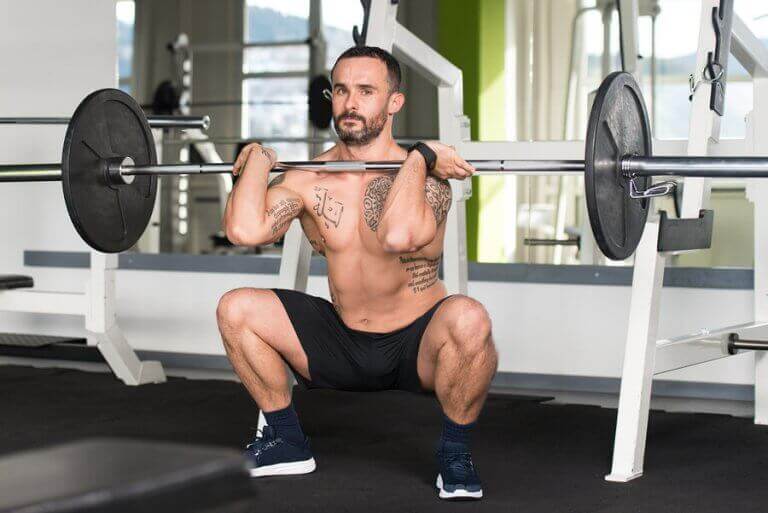The Importance of Strength Training for Cycling

As we all know, cycling is a sport in which the most important physical quality is endurance. However, we must give strength training the right levels of importance, as it will help us obtain an ideal amount of endurance when cycling.
In today’s article, we’ll look into the importance of strength for cycling. We’ll also learn about how we should train to increase our efficiency when riding the bike.
Strength training for cycling
As we mentioned above, strength training is very important for this sport, especially if we’re talking about competitive cycling. If we stop to analyze the biomechanical movements that a rider performs, we can see that every single time they pedal, it requires force.
Without going any further, if we train our maximum strength, we’ll be able to boost our power. This will reflect at a higher speed when sprinting, which will, in turn, improve our endurance.
Because of the work we put into that maximal strength, our muscles will gain muscular endurance, as they’ll be able to maintain a bigger workload for a longer period of time. This last aspect will help us when we have to improve our resistance; we’ll be able to move more with less effort, and therefore, a smaller oxygen expenditure.
The benefits of strength training for riders
Working on your strength correctly can bring many benefits when cycling. Some of them are:
- An increase in the maximum power when transferring force each time you pedal.
- Improvement of your aerobic power, which you should complement with good endurance training.

- The athlete will be more efficient and economic when pedaling.
- It contributes to the prevention of injuries, and can even reduce the risk by half with a good exercise program.
Other factors related to strength improvement and cycling
Besides the benefits we just mentioned, it’s important to talk about other factors that will benefit from a good strength training program for cyclists:
- Strength training will help with fat burning, since oxygen consumption after the workout will increase.
- We must avoid (at all costs) training for hypertrophy. Instead, focus the exercise on developing strength through a neural pathway. On the contrary, we run the risk of becoming much heavier on top of the bike and losing a certain amount of ability when facing mountain bike riding.
How to perform efficient strength exercises?
To get ideal results when strength training to improve our cycling and develop our endurance, we must take the following aspects into account:
- Focus on long-term strength training, as you won’t see results up until 10-12 weeks have passed. It’s important to keep this type of training for preseasons. This is because, after strength training, we’ll probably feel heavier on top of the bike.
- Ideally, we should separate strength and endurance training sessions. Working on both qualities at the same time can jeopardize the possible improvements that we’re trying to achieve.
- If we choose to do strength and endurance training at the same time, it’s fundamental to start with the most demanding part of the program first.

- Work with few reps and heavy loads. When doing fewer reps, we’ll avoid falling into hypertrophy while improving our strength through a neural pathway, which is what we’re mostly interested in.
- As for the pace at which we perform the movements, remember that it’s a cyclic sport. This means that it’s convenient to use a low moving speed. Doing so will allow us to work on the contraction capacity and to generate strength on our slow fibers.
- You have to stick to the program for approximately 8 weeks, performing 2 specific weekly sessions. Ideally, you should perform this part of your training program before the most important competitive peaks, trying to maintain at least part of the work during the season.
- Maintaining this strength work throughout the whole season will allow us to not throw away the endurance improvements that we achieved through strength training. To do this, one weekly session of strength training will be more than enough.
What kind of strength training exercises should I do for cycling?
It’s important to know that strength training for cycling isn’t the same as for playing soccer, for example. We must clearly know how the movement pattern looks when cycling and from there on, select the exercises that adapt the best to it.
The exercises that we choose to improve our strength in this sport should be very similar to the pedaling motion. At the same time, it’s convenient to lean towards global exercises instead of analytical ones.
If we analyze the pedaling motion, we can see that it’s a concentric movement, which is why the exercises that we choose must share this characteristic. In this case, we can select exercises such as squats, hip extensions or the leg press. These movements perfectly adapt to the qualities that we previously mentioned.

Don’t overlook working out on your bike
However, we can’t forget about a fundamental factor when it comes to strength training for cycling: specificity. If our goal is to quantitatively improve our power, at the end of the day, the best tool to do this is the bike.
Therefore, we must also perform short exercises with long recovery periods while riding the bike. As we mentioned before, this is a specific type of training you can do at the gym.
In summary, strength training plays a fundamental role if we want to develop our endurance in a sport that has an essential aerobic component. With this goal, it’s important to adapt strength training to the specific characteristics of the sport we practice, in this case, cycling.
As we all know, cycling is a sport in which the most important physical quality is endurance. However, we must give strength training the right levels of importance, as it will help us obtain an ideal amount of endurance when cycling.
In today’s article, we’ll look into the importance of strength for cycling. We’ll also learn about how we should train to increase our efficiency when riding the bike.
Strength training for cycling
As we mentioned above, strength training is very important for this sport, especially if we’re talking about competitive cycling. If we stop to analyze the biomechanical movements that a rider performs, we can see that every single time they pedal, it requires force.
Without going any further, if we train our maximum strength, we’ll be able to boost our power. This will reflect at a higher speed when sprinting, which will, in turn, improve our endurance.
Because of the work we put into that maximal strength, our muscles will gain muscular endurance, as they’ll be able to maintain a bigger workload for a longer period of time. This last aspect will help us when we have to improve our resistance; we’ll be able to move more with less effort, and therefore, a smaller oxygen expenditure.
The benefits of strength training for riders
Working on your strength correctly can bring many benefits when cycling. Some of them are:
- An increase in the maximum power when transferring force each time you pedal.
- Improvement of your aerobic power, which you should complement with good endurance training.

- The athlete will be more efficient and economic when pedaling.
- It contributes to the prevention of injuries, and can even reduce the risk by half with a good exercise program.
Other factors related to strength improvement and cycling
Besides the benefits we just mentioned, it’s important to talk about other factors that will benefit from a good strength training program for cyclists:
- Strength training will help with fat burning, since oxygen consumption after the workout will increase.
- We must avoid (at all costs) training for hypertrophy. Instead, focus the exercise on developing strength through a neural pathway. On the contrary, we run the risk of becoming much heavier on top of the bike and losing a certain amount of ability when facing mountain bike riding.
How to perform efficient strength exercises?
To get ideal results when strength training to improve our cycling and develop our endurance, we must take the following aspects into account:
- Focus on long-term strength training, as you won’t see results up until 10-12 weeks have passed. It’s important to keep this type of training for preseasons. This is because, after strength training, we’ll probably feel heavier on top of the bike.
- Ideally, we should separate strength and endurance training sessions. Working on both qualities at the same time can jeopardize the possible improvements that we’re trying to achieve.
- If we choose to do strength and endurance training at the same time, it’s fundamental to start with the most demanding part of the program first.

- Work with few reps and heavy loads. When doing fewer reps, we’ll avoid falling into hypertrophy while improving our strength through a neural pathway, which is what we’re mostly interested in.
- As for the pace at which we perform the movements, remember that it’s a cyclic sport. This means that it’s convenient to use a low moving speed. Doing so will allow us to work on the contraction capacity and to generate strength on our slow fibers.
- You have to stick to the program for approximately 8 weeks, performing 2 specific weekly sessions. Ideally, you should perform this part of your training program before the most important competitive peaks, trying to maintain at least part of the work during the season.
- Maintaining this strength work throughout the whole season will allow us to not throw away the endurance improvements that we achieved through strength training. To do this, one weekly session of strength training will be more than enough.
What kind of strength training exercises should I do for cycling?
It’s important to know that strength training for cycling isn’t the same as for playing soccer, for example. We must clearly know how the movement pattern looks when cycling and from there on, select the exercises that adapt the best to it.
The exercises that we choose to improve our strength in this sport should be very similar to the pedaling motion. At the same time, it’s convenient to lean towards global exercises instead of analytical ones.
If we analyze the pedaling motion, we can see that it’s a concentric movement, which is why the exercises that we choose must share this characteristic. In this case, we can select exercises such as squats, hip extensions or the leg press. These movements perfectly adapt to the qualities that we previously mentioned.

Don’t overlook working out on your bike
However, we can’t forget about a fundamental factor when it comes to strength training for cycling: specificity. If our goal is to quantitatively improve our power, at the end of the day, the best tool to do this is the bike.
Therefore, we must also perform short exercises with long recovery periods while riding the bike. As we mentioned before, this is a specific type of training you can do at the gym.
In summary, strength training plays a fundamental role if we want to develop our endurance in a sport that has an essential aerobic component. With this goal, it’s important to adapt strength training to the specific characteristics of the sport we practice, in this case, cycling.
All cited sources were thoroughly reviewed by our team to ensure their quality, reliability, currency, and validity. The bibliography of this article was considered reliable and of academic or scientific accuracy.
- Hopker, J., & Jobson, S. (2012). Performance Cycling: The Science of Success. A&C Black.
- Sunde, A., Støren, Ø., Bjerkaas, M., Larsen, M. H., Hoff, J., & Helgerud, J. (2010). Maximal strength training improves cycling economy in competitive cyclists. The Journal of Strength & Conditioning Research, 24(8), 2157-2165
- Young, W. B. (2006). Transfer of strength and power training to sports performance. International journal of sports physiology and performance, 1(2), 74.
This text is provided for informational purposes only and does not replace consultation with a professional. If in doubt, consult your specialist.








